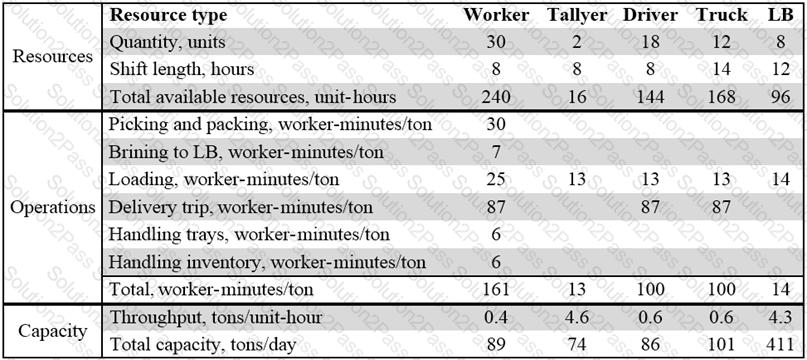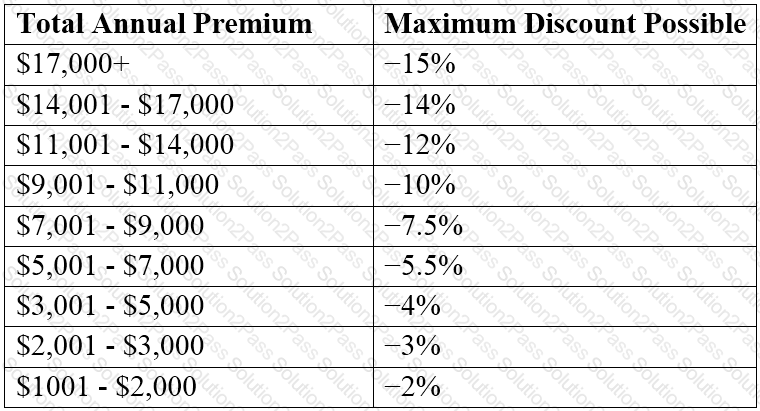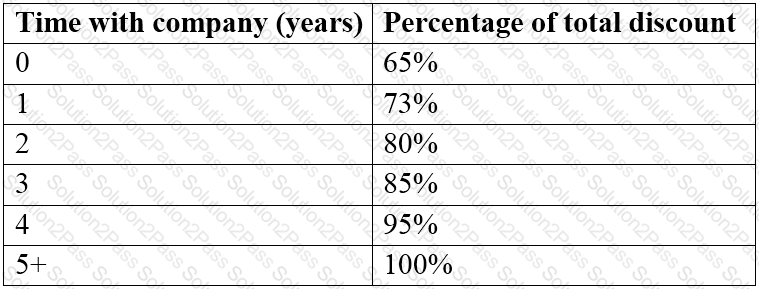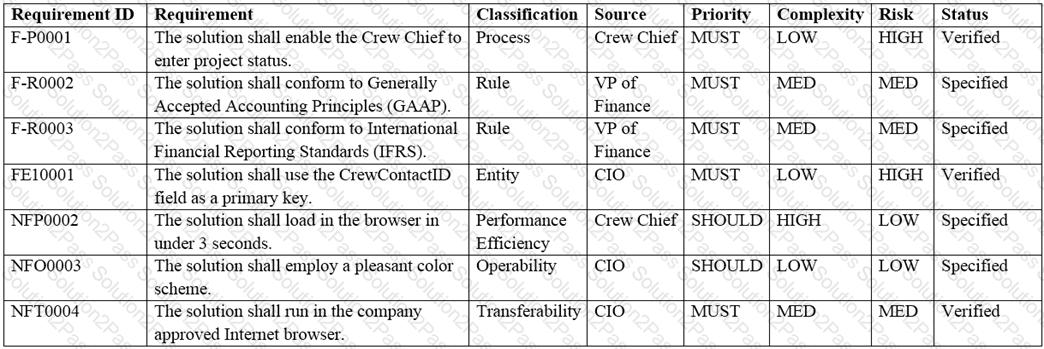CBAP IIBA Certified Business Analysis Professional Free Practice Exam Questions (2025 Updated)
Prepare effectively for your IIBA CBAP Certified Business Analysis Professional certification with our extensive collection of free, high-quality practice questions. Each question is designed to mirror the actual exam format and objectives, complete with comprehensive answers and detailed explanations. Our materials are regularly updated for 2025, ensuring you have the most current resources to build confidence and succeed on your first attempt.
A company has a process improvement initiative that is projected to increase revenue by $150,000 USD non- compounded per year. The budgeted cost of the initiative is $200.000 and supporting the initiative will cost
$30.000 for years two and three.
What is the projected return on investment over the first 3 years?
A financial institution engaged in mortgage lending has embarked on a business process improvement initiative to eliminate the activities that hinder growth to ultimately improve the success rate of its mortgage business. As a benchmark for identification, the institution is keen on improving any business process that has less than a 75% success rate. The institution has appointed a business analyst (BA) to review the business transactions for the processes of origination, payments, and closures, as well as identify opportunities for improvements and recommend solutions.
The BA has collected the following information over the last three months pertaining to these business processes:
•All the business processes are at their maximum capacity in terms of the current number of transactions.
•Each business process has a certain number of rejects and the reasons for rejection include documentation, verification, collateral, and funding. Funding rejects occur when the bank's customers have failed to make payment of their mortgage processing fee or mortgage closure payment.
The BA has also recommended the use of documentation checklists as a solution to eliminate the documentation rejects.

If the financial institution always works at full capacity month to month and the new success rate continues to remain the same after implementing the BA's recommendation, what is the average number of successes per month for the mortgage closure process, if the current process capability were increased by 50%?
An organization is trying to streamline its current processes to improve performance and reduce costs. A business analyst (BA) conducted a process improvement workshop and identified the following issues as the top three items to be addressed:
1: There are multiple teams to define systems, functionality, and content, in many instances, multiple teams are defining the same Functionalities while other functionalities are not being defined at all. leading to unclear understanding of business requirements
2: Product specification forms are published each year. A comparison tool is used to evaluate specification differences between yearly releases; but does not adequately identify changes between versions and needs to be improved.
3: Training consists of a new team member shadowing a seasoned team member. There are no written training materials or formal training sources therefore training is inconsistent and not meeting the needs of the organization.
The BA learns that formal training programs are not often devised for teams as small and diverse as this team, but still believes it is a viable solution to the training need. What type of analysis would help the BA gain approval to proceed with creating this type of training program for this team?
The performance of a newly implemented document management system is falling significantly short of the measures defined as part of the project. However, the business is recognizing some level of value from the system. The business analyst (BA) considers the only option available to the company to increase performance and determines that the cost of implementing the option is ten times higher than the expected benefits. What should the BA recommend?
A business analyst (BA) has just completed a number of elicitation activities and is preparing to review the stated requirements. As part of this, the BA is checking the compliance of the stated requirements with organizational standards for business analysis.
What state is the BA attempting to move the requirements into?
A popular department store chain wants to make computer upgrades as well as conduct a major remodeling effort to increase revenue to all their 100 stores over the next 2 years. The remodeling will occur in two phases. The two phases are required at each store and can be completed in any order, but each phase must be fully completed before the next phase can begin. Phase 1 will take approximately 32 weeks and will not require a store to be temporarily closed. Phase 2 will take approximately 20 weeks and will require a store to be temporarily closed.
In order to keep inventory level and total revenue for the department store chain at an operational level, 75% of the stores must remain open to the public at all times. Against the board of director's advice, the Chief
Executive Officer (CEO) made a decision to start and complete the top 25 revenue-producing stores in the first year to get those stores remodeled and fully operational.
A business analyst (BA) has been brought in to help with planning the project and gathering requirements. Based on the CEO's executive decision, which risk tolerance attitude is the CEO exhibiting?
A national branch of a global company is struggling to improve business processes of its Public and Government Affairs (PGA) department. To work with external stakeholders effectively, PGA employees need to collect, manage, and exchange a vast amount of information. Complex cases involve collaboration of many employees from different departments. The ability to share information and to coordinate corresponding activities is crucial for the company's growth plans. Their current tools and practices do not serve the purpose well. The existing system, which was deployed a couple of years ago, has only a few active users. The majority of PGA employees avoid using it because the system is hard to use and lacks needed functionality. Consequently, available information is mostly unstructured and stored either locally or on a shared network drive. Some of the information exists only in a paper form.
The branch's PGA head, who sponsors the project, wants to implement a configurable solution that two other branches successfully deployed several months ago. Both deployments were done by three solution consultants, who will be available to assist in the project. They will be responsible for tailoring the solution to PGA needs, as well as for training the PGA staff. With their help, the sponsor plans to complete the project in approximately three months.
The solution consultants reside in another country 7 hours ahead of the rest of the project team. They will be available part-time, but are planning two one-week long trips to the PGA central office to conduct initial training and to participate in the final deployment of the system into production. The consultants, in turn, expect a business analyst (BA) to assist in collecting necessary data and defining customization requirements.
The solution consultants have composed a spreadsheet with all requirements that are already implemented in the solution. The requirements in the catalog are organized partially by user tasks and partially by system features. The branch has distinct definitions of PGA user roles and uses a different approach to structuring requirements specifications.
How should the BA organize the customization requirements?
A very large insurer of General Liability and Property Damage insurance has an upward trend of increased claims over the past 5 years.
The Risk Control Area for that company has just completed a 12 month Pilot of a new improved Risk Control Site.
The purpose of the site is to help their customers manage their exposures and ideally prevent them from having claims There were 100 customers that were part of the Pilot that represented 25 different industries. The business goals were to increase use of the site and provide tools to help customer awareness of their exposures, so that they may reduce existing exposures and ultimately reduce claims.
The sites Features were as follows:
* Improvements to the search engine to all customers to search for articles, tools and services on the site
* A checklist function that allow customer to create their own unique Checklists or utilize a sample provided by ABC company to use daily, weekly etc for an area of their facility.
* A promotion feature - where Risk preventing Articles, and tools on the site are marketed toward a customer.
* A profile section allowing for Customer Name, Address and contact Phone number.
Alter the 12 month pilot the business sponsor received an assessment of what was working and what was not. The Assessment of the pilot revealed overall site activity had significantly increased, however only 5% of the time the promotions were viewed. And the most shocking was that total claims increased by nearly 20% for these 100 customers during the pilot period. The business sponsor was perplexed as he had an expectation of reduced claims and at least for 30% viewing of promotions since the project team had spent a lot of careful time and effort on this feature. A BA was assigned to do further analysis regarding the low use of the promotions and why claims were not being reduced.
Regarding the use of promotions the BA looked into other similar companies to see what they did differently to get their customer to look at their promotions. The BA found that similar companies had promotions that targeted the industry the customer was in so it was more relevant to them and they were more interested to view the promotion. In addition the BA sent out a survey to all 100 pilot customers asking probing questions about what they thought of the site and if they felt it had decreased their exposure to risk sufficiently. The Survey responses came back with raving positive comments and providing examples of how the site had been helping in the reduction of claims from the customer's perspective. In addition the survey also revealed insight that the customers found the promotion often irrelevant to their industry.
The BA asked for a dump of all documentation of the 1000 claims that were filed over the 12 month pilot period. The BA found the nearly 90% of the claim filed were all in one region of the country and were all for property damage related to several severe winter storms in the region and the claims were nearly all unavoidable by the customers. The BA brought all this analysis back to the business sponsor and made the recommendation to the business sponsor to require the customer to select 1 of 25 industries in their profile. This would in turn allow for the ability to show industry specific promotions and promote search results relative to a customer's industry to be sorted at the top giving the customer a more personalized experience.
What technique led the BA to the source of the increase in claims?
A major manufacturer of popular beverages has appointed a local distributor to serve a specific territory. The demand for the beverages has a pronounced seasonal pattern. The distributor performs well overall, but is repeatedly unable to keep up with fulfilling many customer orders during peak demand periods. The distributor's current delivery capability is stretched to deliver 60 tons of merchandise per day whereas the season's peak demand periods need a daily delivery capability of up to 100 tons.
The distributor is under pressure to fully meet the year-round market demand in order to stay in business. The distributor's management wants to identify and consider more cost-effective options as resorting to adding more trucks and drivers would not be economically feasible.
A business analyst (BA) has spent several days observing and measuring the warehouse activities to understand the situation and to gain insights into possible solutions. The delivery workflow is a four-step process: (1) picking the orders and assembling them on trays, (2) bringing the trays to the loading bay, (3) loading the orders into trucks, and (4) delivering the orders to customers. As the following table illustrates, overall performance depends is dependent on five major resources: (1) the workers who pick the orders and load them into trucks, (2) the tallyers who check the orders, (3) the drivers, (4) the trucks, and (5) eight loading bays (LBs).

Each truck can only make two trips a day. The BA has noticed that only 30% of trips have their orders available for loading when a truck arrives. Otherwise the truck has to wait one extra hour until the orders are picked and brought to the loading bay.
If trucks are the only constraint, approximately how many hours are lost due to this downtime?
An insurance company wants to increase sales by 15% and customer retention by 10% within 1 calendar year.
Various strategies to achieve this were considered and a restructure to the existing pricing model is selected to help achieve these goals.
A business analyst (BA) works with stakeholders such as actuaries, product specialists, sales staff, risk managers, and underwriters who agree to applying varying levels of discounts to customers based on:
•Total annual premium the customer has with the company (Financial worth)
•Time with the insurance company (Loyalty)
Various financial models are considered but the stakeholders agree that an initial applicable discount is determined based on the customer's overall premium:

The percentage of the maximum possible discount available to the customer is adjusted based on time with the company:

If within the first six months, customer retention increased by 5 % and sales increased by 6%, then when will the desired sales and retention goals be achieved assuming the trend continues at the same pace?
A business analyst (BA) is working on a payment system (PS) implementation. A set of systems which should interact with a new system has been identified. The business analyst defined that a user with role of "Supervisor" in the PS must pass a two-factor authentication before an execution of the functions: "Change system parameters" and "Set up new supervisor." A user must have the role of "Supervisor" to use the standard functions "Send mail notification" or "Send SMS notification".
The BA defined the following use cases:
•"Change system parameters"
•"Setup new supervisor"
•"Send mail notification"
•"Send SMS notification"
•"Send notification"
•"Pass a two-factor authentication"
The BA wants to create a Use Case diagram.
Which technique should be used to define a communications protocol between the PS and other systems?
A company with a big information technology (IT) department has hired a lead business analyst (BA) to enhance its business analysis practices. The lead BA discovers that sponsors are not satisfied with project outcomes. Developers complain about incomplete, ambiguous, and changing requirements. All stakeholders, including project managers, are blaming long cycles of analysis for the delays. The business analysts, in turn, feel overwhelmed with the number of projects and frustrated by the lack of collaboration from reviewers of their deliverables. All of the evidence is anecdotal and none of the groups could strongly substantiate their opinions.
The lead BA wants the BAs to report anticipated and actual completion dates for their deliverables, as well as the time spent on planned and unplanned activities. What is the lead BA trying to do by analyzing the results of such measurements?
Company A is a nation-wide leader in commercial demolition. Having just celebrated its 100th year of operations, the company decided to begin doing work internationally. The current system used for reporting company finances is unable to keep pace with the potential demands of doing work in geographically dispersed locations. Therefore, the company decided to replace its client-based Profit & Loss (P&L) reporting system with a more robust, web-based system. This will ensure transparency across the organization and enable better decision making.
The business analyst (BA) at Company A has recently completed several rounds of elicitation to determine the requirements for the new, web-based system. Over 1250 requirements were elicited. An initial Requirements Traceability Matrix (RTM) has been drafted, and a subset of the RTM can be seen below:

While verifying the requirements, the BA notices that Requirement ID NFO0003 does not meet the "unambiguous" or the "testable" characteristics of requirements quality. The BA plans to re-write the requirement.
Which of the following requirements is both unambiguous and testable?
Company A is a nation-wide leader in commercial demolition. Having just celebrated its 100th year of operations, the company decided to begin doing work internationally. The current system used for reporting company finances is unable to keep pace with the potential demands of doing work in geographically dispersed locations. Therefore, the company decided to replace its client-based Profit & Loss (P&L) reporting system with a more robust, web-based system. This will ensure transparency across the organization and enable better decision making.
The business analyst (BA) at Company A has recently completed several rounds of elicitation to determine the requirements for the new, web-based system. Over 1250 requirements were elicited. An initial Requirements Traceability Matrix (RTM) has been drafted, and a subset of the RTM can be seen below:

The BA will create a Data Model to meet which requirement?
A business analyst (BA) is planning for an upcoming solution based on a signed contract with a client but has learned that one of the key subject matter experts is unavailable during the first half of the business analysis phase. The project has a tight timeline and firm deadline that is part of the contract. There are no substitutes for the key subject matter expert.
How should the BA proceed?
During requirements review, the implementation subject matter expert (SME) identified the requirement 'parsing of data' that must be implemented before other requirements. The business analyst (BA) has given this requirement high priority.
What factor influenced the prioritization of the requirement?
A software development company is in the process of creating a new product for their customer base. It has been several years since such a project has been initiated and the organization has created a new team to own and develop the product. The project team will be evaluated by the successful adoption of the product, which will be developed over the next 12 months.
The team's business analyst (BA) has analyzed the current state in partnership with the product owner and has been meeting with senior management to identify the goals that need to be attained. A broad view of the business has been analyzed in order to have an understanding of how the company is currently providing value to its customer base.
After the BA completed the initial analysis, the information is reviewed with leadership. At this point in the project, what will the BA be presenting?
A non-profit utility company has 900 employees, a majority of whom are hourly employees and must track their time using a paper based process. A few years ago, the Director of Human Resources purchased a software system to eliminate the current paper-based time reporting process. No requirements specific to the utility company were defined prior to the purchase. A team was formed to implement the software During implementation process, the team discovered the software lacked functionality and was not robust enough to support the general ledger requirements The company stopped the effort and incurred a $500,000 USD loss on the cost of the software.
This year, the Director of Finance requested that a team investigate the current paper-based time reporting process and recommend solutions. The Director of Finance feels that the Director of Human Resources must be involved as a critical stakeholder. The Director of Human Resources is still bitter about the last effort because the process stopped'.
Which of the following is included in performing a stakeholder analysis?
A company finalized the implementation of a new, corporate-wide database. After nearly three months of operation, the solution is repeatedly producing invalid outputs. A business analyst (BA) has been asked to investigate the solution's problem. The BA has been able to find several instances where the outputs from the solution are below an acceptable level of quality.
Which of the following techniques should the BA use to identify the solution limitations?
The BA Is finalizing the definition of the requirements architecture by understanding how requirements relate to each other. A key component that must be apparent in all three diagrams is that none of the requirements be linked in different or conflicting ways. What relationship quality criterion does this represent?
